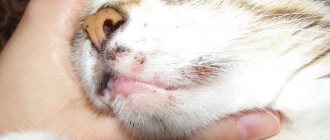What does a subcutaneous mite look like in cats?
There are 2 types of ticks in cats:
- Demodex cati.
Demodex cati is a permanent inhabitant of the cat’s body and is generally a peaceful resident. The variety can be transmitted from mother to kittens in the first days after birth. Not contagious to other animals. The body is narrow, elongated in length, approximately 0.5 mm. Habitat: hair follicles. This is the most favorable place for the parasite: there is food in the form of lymph, blood, dead cells, and optimal temperature.
D.cati is a cat's friend, as it eats dead skin cells and sebaceous secretions. But he becomes an enemy when his food turns out to be of “poor quality” due to the animal’s health problems.
A tick attack by D. cati begins when the pet’s immunity is weakened, under poor living conditions, or when taking drugs to artificially suppress the immune system. Therefore, demodicosis cati is almost always accompanied by chronic viral infections: peritonitis, immunodeficiency, leukemia. The tick in a cat can become more active against the background of diabetes mellitus and lupus erythematosus.
- Demodex gatoi.
Demodex gatoi are highly contagious. They live in the stratum corneum of the skin and do not affect the hair follicle. The body is short and wide. Infection occurs through contact with a sick animal. But a person can also bring a dangerous “fragment” of fur with parasites into the house. This is how completely domestic pets that do not walk on the street become infected. It is noted that the activation of this type of parasite is not associated with weakened immunity.
What is demodicosis
Demodicosis is a dermatological (skin) disease that develops as a reaction of the body to the presence of demodex mites in the body. It has been scientifically proven that demodex mites are present in the body of 90% of the planet's inhabitants, but not everyone experiences the disease. This disease can be called seasonal, as it worsens during the autumn suppression of immunity. Also, with age, the tendency to this disease increases. Children are less susceptible to developing demodicosis - this is associated with less sebum production. The mite, as a rule, settles in the sebaceous ducts of the skin or hair follicles, and when the body is weakened, it is activated, which manifests itself as a skin rash similar to acne. Most often, the parasite affects the skin on the face - forehead, nasolabial triangle, eyelids, chin, and outer ear area. The rash also sometimes spreads to the head, back and chest. The rash is formed as a result of the body’s reaction to the waste products of the tick. The first symptoms by which a skin disease can be recognized are inflammation of the skin, including acne. The disease is also accompanied by:
- itching;
- tingling;
- the affected areas of the skin peel off;
- pores are enlarged.
If the pest has settled in the eyelids, a purulent compartment forms in the corners of the eyes, eyelashes become thinner and may even fall out. At the same time, the eyelids become heavier, redness appears, and scales may appear near the base of the eyelashes. When the activity of the mite intensifies near the tear duct of the eye, dry eye syndrome may develop. Seborrhea forms on the scalp with demodicosis. It manifests itself as increased sebum secretion (hair quickly becomes oily) and hair loss. Also, the presence of a mite is determined by examining the eyelash and eyebrow hair - the pest can hide in the eyelash follicle, but due to its small size, it can only be seen with a microscope. Since the tick lives at rest in the deep layers of the skin, the disease can be provoked by deep cleansing of the skin (peeling), visiting a sauna or steam bath (when steaming, the pores of the skin open and the tick comes out into the upper layers).
Causes of red scabies
Subcutaneous mites in cats occur in all breeds. There are no restrictions by gender or age. However, it has been noted that Siamese and Burmese breeds are more often affected.
At risk:
- Animals with weakened immunity due to genetic diseases, previous infections, infection with worms, fleas, and those who have been treated with antibiotics for a long time.
- Pets up to 1-2 years old and over 5 years old.
- Kittens are artificial or taken from their mother early.
- Cats with skin diseases, wounds, abrasions.
No less influence on the immune system is exerted by nutrition, living conditions, and exposure to stress.
Anti-tick drops for cats
Medicine in the form of drops is very common, as it is one of the safest and most affordable. It is used not only to combat infection, but also to prevent otodectosis.
The course of treatment begins with the use of an emulsion, the fundamental component of which is Fipronil, Fenthion or Permethrin. The product must be rubbed into the skin of the withers and make sure that the animal cannot lick it off until it is completely absorbed.
To treat ear mites in cats, the following brands of drops are usually used:
- Celandine (the active ingredients of the drug are Fipronil and Permethrin).
- Biafar (differs from other drops by the presence of a natural component based on margose, which destroys insects).
- Leopard (the main component is Permethrin) is low toxic for cats, which explains its popularity.
- Frontline (the active ingredient of the drug is Fipronil) is effective against ear mites and their carriers, fleas.
Signs and symptoms
If subcutaneous mites are suspected in cats, symptoms and treatment depend on the form of the disease. There are 3 of them in total.
Localized form
When the parasite penetrates the skin, inflammation occurs at the site of penetration. The skin swells and turns red. Small tubercles (3 mm in diameter) with blood or pus form. There are a lot of such elements, especially if timely treatment is not undertaken. The danger is that an infection occurs, causing the animal’s condition to worsen. Otitis media develops, focal baldness develops, the skin turns red, becomes covered with ulcers and scales. Therefore, this form is also called “scaly”.
With local demodicosis in cats, symptoms appear primarily in the area around the eyes, ears, head, and neck. There are no more than 5 lesions. The hair on them noticeably thins. The paws and back remain unaffected. D. cati does not cause concern to the animal, while D. gatoi causes severe itching. The localized form often goes away on its own in 1-1.5 months.
Generalized demodicosis
When the disease process spreads throughout the body, the following manifestations are observed:
- Areas of hair loss throughout the body.
- Redness, hyperpigmentation of the skin.
- Acne, pustular rashes.
- Inflammation of the outer ear.
- The skin peels severely, bleeds, and itches unbearably.
- Fungal and bacterial infections are added.
The head, muzzle, neck, lower and lateral sides of the torso, and limbs are most often affected. With D. gatoi, complete baldness of the affected part of the body occurs. The animal may look untidy. The wool is dull, as if sprinkled with flour, sticks together. Many owners mistakenly believe that it is dandruff. The skin becomes shiny, sticky, and an unpleasant odor begins to emanate from the cat.
The disease progresses quickly. Separate foci are connected. Most of the body is affected by Demodex. The skin becomes thicker and gathers into folds, making the head seem prohibitively large compared to the body. The eye shape narrows. Lymph nodes become inflamed - this symptom is characteristic of demodicosis.
The general condition is depressed. The cat may refuse food and not be active. Possible increase in body temperature. The disease spreads throughout the body, and signs of intoxication begin to appear.
Juvenile demodicosis
It differs from generalized only in that it is inherited. The kitten becomes infected while still in the womb. This is a very severe form, as the entire cat’s body is affected.
Anti-tick collar for cats
But not only drops have the same effect on ticks and fleas: the most popular is a special collar against parasites. And this is explained by its undeniable advantages:
- simplicity and ease of use;
- safety for the cat;
- efficiency of application.
A high-quality flea and tick collar for cats is the best choice for the treatment and prevention of otodecosis. When choosing a product, pay attention to its characteristics:
- A quality product is always sealed in a foil bag.
- The collar should be intended only for cats (also separately for kittens and for pregnant or lactating pets).
- The material should not contain: Permethrin, Amitraz and organic phosphates.
How to treat demodicosis in cats
The main goal of therapy is to eliminate the pathogen. For this purpose, injections, ointments, solutions for internal use, sprays, and bathing are prescribed. Be sure to use products to strengthen the immune system, restore the condition of the skin, and adjust the diet for vitamins and proteins. Treatment of demodicosis in cats is complex.
There is no one universal remedy that can remove the parasite. Having discovered a tick in cats, the doctor prescribes a comprehensive treatment, combining medications.
Therapy for local form
The disease caused by D. cati and characterized by local damage can go away on its own, but not if the immune system is weakened.
The main treatment for cats with demodicosis:
- Use of Amitrazine solution once a day with an interval of 3 days. In this case, it is important to treat not only the affected area, but also the area a centimeter nearby. On average, 6-8 treatments are required for the signs of demodicosis to disappear. The drug is well tolerated by animals. However, if there is scratching, the pet experiences a burning sensation. To prevent the cat from licking the product, the jaw is closed using a loop. Amitrazine is not only destructive to parasites, but also has an anti-inflammatory and softening effect.
- An effective method of treating subcutaneous mites is considered to be feeding the animal with a 1% Ivermek solution at a rate of 0.3-0.5 mg/kg.
- To get rid of the cat mite D. gatoi, use the medicinal solution Lime Sulfur (lime sulfur). The wool is wetted every 3 days or a week. Duration of treatment is 1-2 months. The first signs of improvement are observed after 3-4 weeks of therapy.
Generalized form
In case of extensive demodicosis caused by D. cati, the following treatment regimen is considered effective:
- Treatment of the entire body with Lime Sulfur solution. The interval is a week.
- Subcutaneous administration of the drug Doramectin. The dosage is calculated strictly under the supervision of a doctor.
- Lubricate the body completely with Amitrazine every 1-2 weeks. The drug should be used with caution in the generalized form, and should not be used at all in animals with diabetes.
In severely advanced cases, treatment of the generalized form is often ineffective.
For any type of disease, treatment of subcutaneous mites in cats requires up to two negative scrapings with an interval of 1 month and elimination of lesions. Therefore, it is possible to cure subcutaneous mites in a cat no earlier than 2 months. Some veterinarians perform 3 control scrapings 2-3 weeks apart.
Home treatment for subcutaneous mites
You need to understand that if you independently diagnose and treat your pet without consulting a veterinarian, you risk causing irreparable harm to the cat. Of course, treatment at home is possible if you first visit a specialist. Basic methods of self-treatment for cats:
- Use calendula tincture to treat all damaged areas on the skin;
- Every two days, bathe your pet in warm water with the addition of chamomile infusion;
- If the areas where the parasite lives are clearly visible, you can periodically treat them with kerosene;
- To wipe the skin, use birch tar or tar soap.
In advanced forms of the disease, one can hardly hope for a complete cure with these methods. They help only during the onset of the disease. You should absolutely not start the treatment process. In this way, you will prevent complications and quickly and painlessly relieve your four-legged friend from suffering.
Are subcutaneous ticks transmitted to humans from cats?
As you know, subcutaneous mites have many varieties. Each species chooses a certain category of victims for itself. Thus, ticks that prefer to parasitize cats are not able to exist and reproduce in the human body. Thus, we can safely conclude that cats with demodicosis are not contagious to humans.
It must be remembered that parasites, with their active development, not only interfere with the animal, but also gradually destroy it. Although an infected cat is harmless to humans, it is contagious to other animals. If there are several pets living in the house, try to prevent them from being in close contact. All care and hygiene items must be personal for each pet. This will prevent infection of healthy animals.
( Video : “Demodicosis or subcutaneous mites in animals | What is demodicosis? | Veterinarian’s advice”)
Preventive recommendations
In order not to encounter such a serious problem as the manifestation of demodicosis in a cat, you must always remember about precautions and prevention measures. Experts say the first and most important preventive measure is a balanced diet for the animal. A properly formulated diet will allow the cat’s body to receive all the necessary substances that help strengthen the immune system. You also need to know other rules:
- Since stray animals are often carriers of various parasites, it is better to protect your pet from contact with them. If you are walking in areas where there is a possibility of such an encounter, it is recommended that you keep your cat on a leash or carry it in your arms. But pets can also become infected. Of course, it is unlikely that it will be possible to completely prevent a pet from communicating with its relatives. But the cat owner must carefully monitor who the pet communicates with;
- Treat fur and skin periodically. To do this, you can use anti-parasitic shampoos. You can also find special sprays, lotions and other medications at the veterinary pharmacy. Even if parasites appear in a cat, they will be quickly destroyed;
- Keep not only the place where your pet sleeps clean, but the entire house. It must be remembered that one of the main factors in the appearance and development of parasites is unsanitary conditions. General cleaning is recommended to be carried out using special disinfectants. Pay special attention to disinfecting toys, dishes, rugs and other favorite things of your pet;
- Vaccination helps minimize the likelihood of infection. To do this, you just need to follow the vaccination schedule. It is recommended to first consult with a veterinarian who will select the safest and most effective vaccine;
- If demodicosis has nevertheless been diagnosed, in addition to the main treatment, it is recommended to give the cat immunostimulating drugs and vitamins. This will allow you to recover from the disease faster.
Caring owners carefully monitor the life of their pet. They try to eliminate all factors that contribute to the manifestation of subcutaneous mites. Remember, demodicosis often appears in animals with poor health. Therefore, you need to feed your cat only healthy and natural food. Do not neglect routine vaccinations, which should be prescribed by a veterinarian.
Drugs
All medications for subcutaneous mites in cats are selected exclusively by a doctor. The list of funds below is for reference only.
| Category | Drug name | additional information |
| Preparations for injections | Infermectin Otodectin Ivermec Novomec | Dosage – 1 ml per 10 kg of weight. The injection is given once a week. Minimum course – 2 weeks. It is administered subcutaneously or intramuscularly. The first method is considered more effective. Control is carried out by scrapings. |
| Dectomax Meradoc | 0.5 ml per medium-sized cat. Repeated injection after 10 days. Lasts for a long time. Has no side effects. | |
| Aversect | 0.1 ml every 5-7 days until recovery. Inserted into the withers or knee fold. | |
| Drugs that increase the resistance of immunity to parasites (immunomodulators) | Immunoparasite Maksidin Gala-vet Gamavit Ribotan | Immunoparasitan is the only drug of its kind that increases the body's resistance specifically against demodex. |
| Acaricidal ointments/gels | Ivermek-gel Amidel gel Neo Aversectin ointment | Treat the affected areas and adjacent areas to a depth of 2 cm. |
| Solutions | Neostomazan Butox Mycodemocid Amit forte Tsipam | The medicine is diluted with water. Use strictly according to instructions. |
| Sprays | Acaromectin Ivermec | |
| Drops on the withers | Stronghold Lawyer | Course – 2-4 months |
| Shampoos | Doctor Elite | Needed to clean the skin of a sick animal. |
| Anti-inflammatory drugs (external) | Ointment Pikhtoin Sea buckthorn oil Saphroderm gel | Used to soften and remove crusts. You cannot peel off the crusts yourself. Demodex begins to multiply with a vengeance, since the secreted sputum (ichor) is its main food. |
| Hepaprotectors | Essentiale Hepatovet Heptral | Any injections with an acaricidal focus place a large load on the liver. Therefore, hepaprotectors are necessary in complex therapy. |
| Nutritional supplements | Sulfur for animals | Administered with food once a day. Dosage 0.04 g. (about the size of a pea). Duration of treatment – 1 month. |
| Vitamins | Aevit Tetravit | To speed up skin recovery. They are given in the form of tablets or injections. |
When an infection is added, antimycotics and antibiotics are prescribed in combination (Amoxiclav, Cefazolin, Tsiprovet, etc.).











